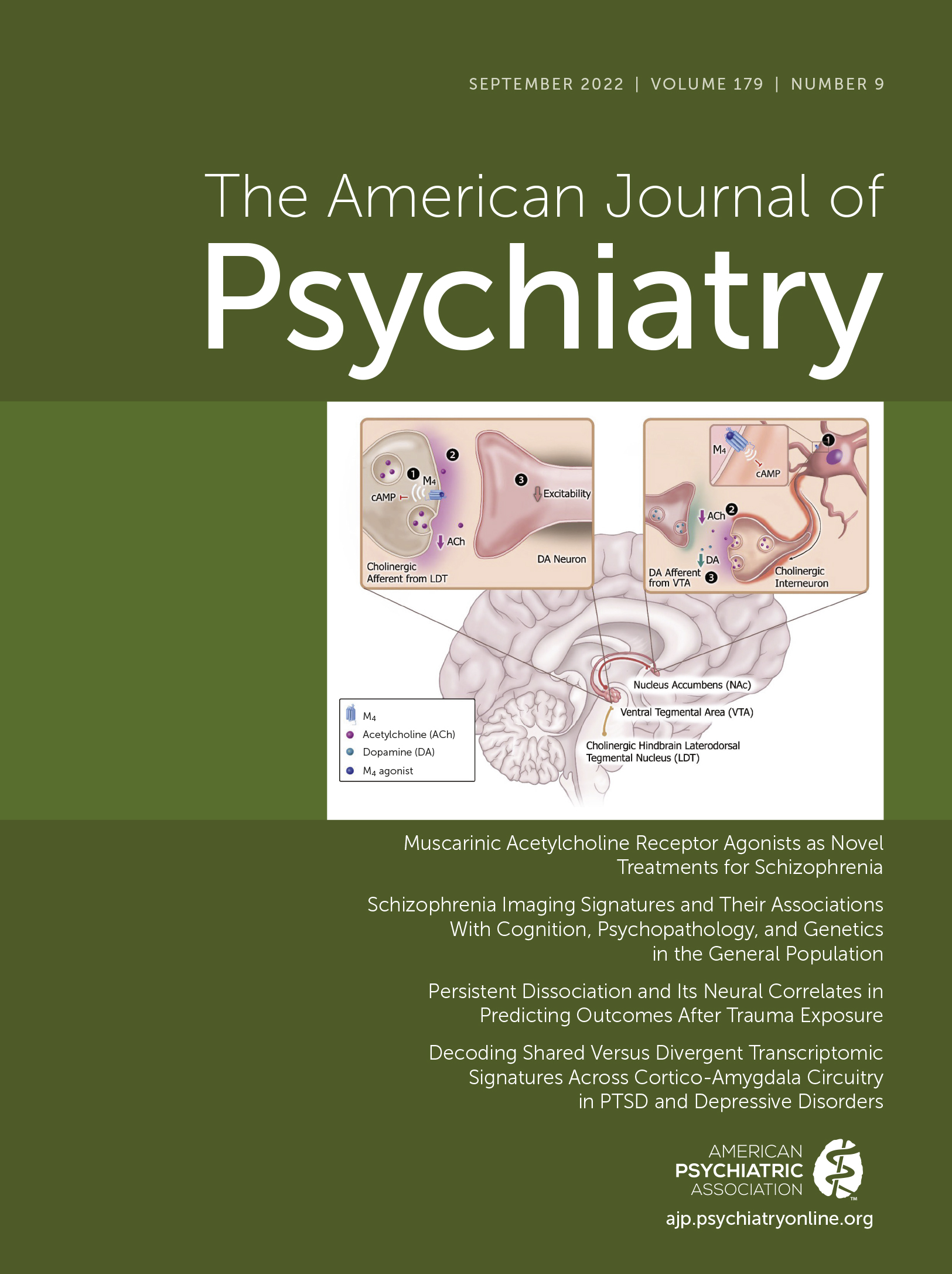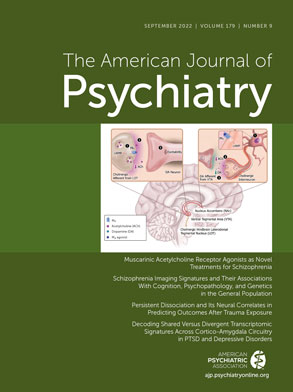“It has always been a puzzle to me that the period of life of maximum disturbance, adolescence, is the one of least interest to both psychiatrists and governments…. [T]he neglect of adolescent psychiatry is a special form of self-harm undertaken by adult society.”
How to identify individuals at highest risk of developing schizophrenia has been a question that has been investigated with energy and enthusiasm by a generation of researchers, clinicians, and patient advocates. The development of predictive models has progressed by including several key factors, including biomarkers, and the best replicated predictions using machine learning models have been on the order of 60%–70% balanced accuracy and higher (
2,
3). This has become a remarkable collaborative effort, and now includes the new international AMP-SCZ project (
www.ampscz.org), which aims to identify risk trajectories of transition from the clinical high risk state to psychotic disorder, by collecting data in over 1,000 subjects at clinical high risk with the stated aim of generating predictive tools that will improve success in selected prevention by developing early-stage interventions for patients who are at risk of developing schizophrenia.
Two articles in this issue (
4,
5) examine the utility of moving the high risk paradigm beyond the help-seeking population into the general population—particularly young people. Chand and colleagues (
4) seek to validate and replicate two neuroimaging “signatures” identified within individuals with psychotic disorders by applying these signatures to a sample of youths with psychotic symptoms. They show that one of the “schizophrenia” signatures (involving widespread reductions in gray and white matter volumes) can be detected in 48% of youths with psychotic experiences (but also in 28.6% of young people who do not report such symptoms), and the authors speculate that the reduced gray and white matter volume “signature” in association with cognitive impairment may indicate early developmental vulnerability to schizophrenia. This fits with models of “neural inefficiency,” which may herald increased risk for later psychosis and can be indexed by reports of psychotic experiences (
6).
Also in this issue, Gregersen and colleagues (
5) focus on an in-depth study of psychotic experiences in children and adolescents in the Danish High Risk and Resilience Study who are already at higher risk of schizophrenia due to family history. They observe that psychotic experiences can be reliably detected as early as age 7 and that these experiences are associated with a twofold increased risk for mental disorders in middle childhood (at age 11). This risk is higher for young people with symptoms that persist or recur and for young people who also have a family risk for psychosis. Gregersen et al. conclude that psychotic experiences can be detected in early childhood (even by age 7) and index a vulnerability for psychopathology both in children at familial high risk and in control children. The authors suggest, in keeping with ourselves and others (
7–
9), that psychotic experiences should be a focus for screening among children at high familial risk and, if detected, should prompt further assessment. Specifically, the authors advise that report of “several types of psychotic experiences and persistent psychotic experiences ought to warrant particular attention.” Persistent psychotic experiences (i.e., reports of psychotic experiences at both age 7 and age 11 in this study) were associated with a fourfold increased risk of mental disorders at age 11 over and above the effect of familial risk. This is a noteworthy risk for mental disorders in childhood, which is in turn associated with risk for adverse mental health outcomes later in adolescence and adulthood and could identify a new clinical high risk group, not just for psychosis but for a range of adverse mental health outcomes (
10).
The studies in this issue provide support for the idea that the paradigm of “high risk” for psychosis should be broadened (
11,
12). Indeed, is the focus on psychotic experiences as a risk factor for later psychotic disorder distracting or diverting us from other clinical presentations that may perhaps allow us to identify more individuals who will later develop a psychotic disorder and to do so in a more efficient manner? Is our focus on the different methods used to predict transition from the clinical high risk state—for example, neuroimaging, psychopathology, and biological markers—obscuring our view of the very nature of the clinical high risk state itself and how it is defined? Primary prevention using some of these tools is expensive and is unlikely to be implementable at population-level screening.
Thus, although the clinical high risk model is effective at identifying some individuals at risk of psychotic disorders, it is inefficient in terms of identifying the vast majority of the population that will develop a psychotic disorder (
13). These challenges have been partially addressed in some countries, notably in Australia, where additional resources have been directed at youth mental health, including primary care centers (Headspace) and a connected referral service with other specialties (e.g., personality disorder services). However, despite this broad and connected service, only 7.6% of individuals with first-episode psychosis had used these services, in addition to the 13% using clinical high risk services (
14), and nearly 80% of those who developed a psychotic disorder did not use any of these services. This suggests that even with a low entry barrier to mental health services, relying on individuals with developing psychosis to come forward and report such difficulties may be insufficient. In particular, the study noted differences based on sex, age, migrant status, and difficulties with substance abuse and use of services, meaning that potentially more vulnerable groups were less likely to use clinical high risk or related services (
14).
The low predictive capacity from clinical high risk services requires us to consider additional approaches to identifying those who will transition to psychosis. Bolhuis and colleagues (
15) have taken a systems approach by utilizing case register data from everyone born in Finland in 1987, including all Finnish hospital records of self-harm presentations. They observed that 18% of young people who present to hospitals with self-harm went on to develop a psychotic disorder over a 28-year follow-up period. This effect was particularly strong for those under age 18 at self-harm presentation, and of these, 29% went on to develop a psychotic disorder. These rates of transition and predictive capacity are broadly similar to those seen in the clinical high risk model, particularly in the younger age group (
2). Critically, no detailed clinical interview is needed to identify these individuals, making it a more efficient route to the identification of high-risk populations.
Undoubtedly, there are other avenues of predictive identification to be identified. These could include young people attending mental health services, early school leavers, or those who engage in early substance abuse. Moreover, these different systems-based approaches, as proposed by Bolhuis and colleagues (
15), are likely to overlap with one another and with the current clinical high risk paradigm, such that some of the same pools of individuals are reidentified. However, casting the widest net possible should increase the number of those identified before psychosis occurs.
We now appear to be approaching a new conceptualization of clinical high risk for psychosis. Undoubtedly, there should be an ongoing focus on the importance of early psychotic experiences, as admirably demonstrated by the studies by Chand et al. and Gregersen et al. in this issue. But in order to identify and treat the greatest proportion of those who ultimately present with psychotic disorders, our focus may need to broaden to include the screening not just of psychotic experiences, but of suicidal ideation, family history, attendance at mental health services, and other potential high-risk groups (
9).
Indeed, perhaps just identifying those “at risk” is enough. If we could focus on the screening and assessment of young people at risk and providing the necessary supports and treatment to improve their functioning and outcomes, we may actually have more of an impact on rates of mental illness in the population than a narrow focus on predicting “transition” among a group of help-seeking individuals attending a specialized service (
16). As we stated previously, “The time has come to look beyond the idea of psychosis as a distinct category of mental illness…. Psychosis does not fit neatly into one chapter of the DSM: on the contrary, it should have a place in every chapter” (
17).
This potential broadening of the mission of the high risk paradigm will finally move psychiatry and psychology out of the clinics and into the realm of public mental health (
18) and should also take a broader view incorporating climate change and biodiversity and their effects on mental health (
19).

